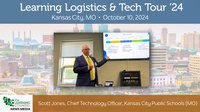CEO GuideK12 Chuck Amos is passionate about helping the educational community. “I love education. If we do our job well we make things a little better, more efficient and more effective for the people working in the districts. The people in this industry are amazing. The fact that I’ve been able to work with so many talented people over the past 25 years leaves me awestruck every day.”
GuideK12 consists of four modules designed for district administrators to visualize every student and all their characteristics on a map or report. The interactive, real-time data analysis tool assists districts in understanding location matters for boundary planning, program placement, school choice, chronic absenteeism, discipline data and much more. Consequently, knowing where a student attends and where they live helps district leaders ensure they are providing the best services in the most convenient locations for the entire student community, which allows districts a clear understanding of impact when changes are needed. “Our tool puts the answers closest to the decision makers. Often people find they aren’t asking the right question at first until they dig deeper into the data,” explains Amos. “We make it easy to do that so ultimately decisions are better.”
GuideK12 was designed for everyone from the superintendent to front office personnel based on their role and their need for easy data analysis. For example, the Adviser module creates basic to complex reports and then transforms the data into a visual graph or chart. Administrators spend less time collecting data and setting up spreadsheet formulas and more time making decisions based on multiple streams of real-time data.
“Schools are awash in data. Administrators aren’t asking for more data, they need tools that help them easily make sense of it all and make informed decisions from it and that is precisely what GuideK12 does,” explains Amos. “We understand first and foremost their job is to educate, so our job is to make our tool easy to use, but powerful enough to help. There are so many important decisions that need a geographic dimension to be truly informed and we make that possible in a way very few can.”
Another module, SchoolSearch is community facing and is a comprehensive, customizable address lookup tool that districts can provide to families. “Five years ago, you didn’t hear many districts discuss marketing or the increasing competitive pressures, but today they need to think about what tools they are providing their community for understanding their offerings and options,” explains Amos. “I get excited to see districts implement our GuideK12 SchoolSearch module and put their district in the most positive light possible.”
Miami Dade Public Schools is one of the largest school districts in the country with over 60 percent of the families not attending their assigned school. Working with GuideK12, the district created an easy way for parents to compare schools. From the district’s website and clicking on a link, a parent enters their address and their assigned school appears. Using an advanced search, the parent qualifies their school selection by picking options like magnet schools, STEM schools, or visual and performing art schools. All the while, the parent compares the available information for each school and decides which school is best for their family.
Guide K12’s Planner module visualizes various scenarios that afford a deeper understanding of the impact of each potential change while keeping the community informed and ultimately providing a solution so people are pleased. “Boundary planning can be difficult and emotional so when GuideK12 can ease that challenge, we are so pleased,” adds Amos.
Explorer is another module that helps administrators examine day-to-day school operations, so they quickly and easily can access information about what is happening in their district. The data is tailored in relation to instructional solutions, formative assessment, and classroom performances. According to Amos, there is a big push for data concerning school operations because such information is lacking in many ways. “Things like where are our kids coming from? Where are we gaining kids? Where are we losing kids? We've had districts that have analyzed things and determined that they had a program or multiple programs in the wrong place,” explains Amos. “We have also saved districts a lot of money by putting programs closest to the students that need them.”
Amos shares a story about one district delivering an ESL program on the opposite side of the district where the bulk of the population needing the ESL program lived. The program was in the right place somewhere along the way, but the community shifted. The administrators never realized a shift occurred. They ended up busing kids at significant transportation costs. Because busing the kids was an hour there and an hour back, many parents opted out of the ESL program. They didn't want their students spending two hours a day on a bus. Collecting the data from Explorer, administrators discovered the situation and moved the ESL program to the other side of the district - saving money and time.
“We pride ourselves on our ease of implementation and the low burden level for the administrative team. We do the heavy lifting for the districts,” explains Amos. “One of the really critical things for any CEO is to lead in a way that really sets the right culture for an organization. Everybody that works here loves the education market. I marvel that I get paid some days to do what I do, because, when we do our job well, it makes the process better. It helps make educators more effective at their job.”











